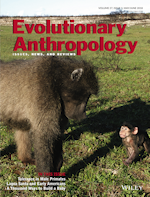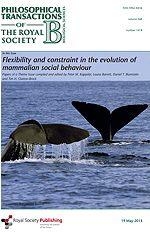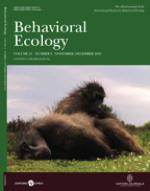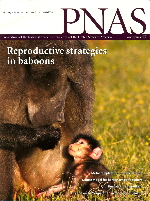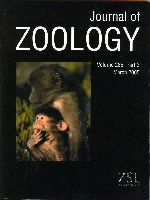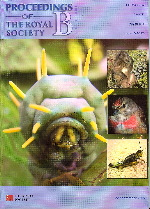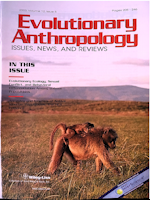Lethbridge publications 2007-
In Press
R. McFarland, L. Barrett, A. Fuller, R. Hetem, W. Porter, C. Young
& S.P. Henzi. In press. Infrared thermography cannot be used
to approximate core body temperature in wild primates. American
Journal of Primatology.
C. Vilette, T. Bonnell, S.P. Henzi & L. Barrett. In press. Comparing dominance hierarchy methods using a data-splitting approach with real-world data. Behavioral Ecology.
T. Bonnell, C. Vilette, C. Young, S.P. Henzi and L. Barrett. In press. Formidable females redux: male social integration into female networks and the value of dynamic multilayer networks. Current Zoology.
C. Nord, T. Bonnell, M. Dostie, S.P. Henzi & L. Barrett. In press. Tolerance of muzzle contact underpins the acquisition of foraging information in vervet monkeys (Chlorocebus pygerythrus). Journal of Comparative Psychology.
P. Mathewson, W. Porter, L. Barrett, A. Fuller, S.P. Henzi, R.
Hetem, C. Young & R. McFarland. In press. Field data confirm
the ability of a biophysical model to predict wild primate body
temperature. Journal of Thermal Biology.
2020
R. McFarland, L. Barrett, M-A.Costello, A. Fuller, R. Hetem, S.
Maloney, D. Mitchell, P. Henzi. Keeping cool in the heat:
Behavioral thermoregulation and body temperature patterns in wild
vervet monkeys. American Journal of Physical Anthropology 171:
407-418.
M.M.I. Young, S. Winters, C. Young, B.M. Weiß, J. Troscianko, A.
Ganswindt, L. Barrett, S.P Henzi, J.P Higham and A. Widdig. Male
characteristics as predictors of genital color and display
variation in vervet monkeys. Behavioral Ecology and Sociobiology
74: 1-14.
J.D. Jarrett, T. Bonnell, M.J. Jorgensen, C.A. Schmitt, C. Young,
M. Dostie, L. Barrett & S.P. Henzi. Modelling variation in the
growth of wild and captive juvenile vervet monkeys in relation to
diet and resource availability. American
Journal of Physical Anthropology 171: 89-99. DOI:
10.1002/ajpa.23960
2019
C. Young, T. Bonnell, L. Brown, M. Dostie, A. Ganswindt, S.
Kienzle, R. McFarland, S.P. Henzi, L. Barrett. Climate induced
stress and mortality in vervet monkeys. Royal
Society Open Science doi.org/10.1098/rsos.191078.
J. Fischer, J.P. Highham, S.C. Alberts, L. Barrett, J.C. Beehner, A. Carter, A. Collins, S. Elton, J. Fagot, M. Ferreira da Silva, K. Hammerschmidt, P. Henzi, C. Jolly, S. Knauf, G. Kopp, J. Rogers, C. Roos, C. Ross, R.M. Seyfarth, J. Silk, N. Mackler-Snyder, V. Städele, L. Swedell, M.L. Wilson & D. Zinner. The natural history of model organisms: Insights into the evolution of social systems and species from baboon studies. eLife 8:e50989 doi: 10.7554/eLife.50989.
A. Jones, T. Bonnell, S.P. Henzi & L. Barrett. A natural history of repetition. Journal of Montessori Research 5: 15-44.
R. Blersch, C. Archer, E. Suleman, C. Young, D. Kindler, L. Barrett & S.P. Henzi. Gastrointestinal parasites of vervet monkeys (Chlorocebus pygerythrus) in a high latitude, semi-arid region of South Africa. Journal of Parasitology 105: 630-637.
C. Young, R. McFarland, A. Ganswindt, M. Minkner, L. Barrett
& S.P. Henzi. Male residency and dispersal triggers in a
seasonal breeder with influential females. Animal Behaviour
154: 29-37.
T. Bonnell, S.P. Henzi & L. Barrett.
Functional social structure in baboons: Modelling interactions
between social and environmental structure in group-level
foraging. Journal of Human Evolution 126: 14-23.
R. McFarland, S.P. Henzi & L. Barrett. The Social and Thermal Competence of Wild Vervet Monkeys. In: Savannah Monkeys. The genus Chlorocebus. (Eds. T.R. Turner, C.A. Schmitt, J. Danzy Kramer), pp. 195-203. Cambridge University Press.
L. Barrett. Enactivism, pragmatism… behaviorism? Philosophical Studies 176, 807-818.
L. Barrett, L. Supercharged Apes versus Super-Sized Minds: Embracing Continuity While Accepting Difference. In: Clark and his Critics (eds. M. Columbo, E. Irvine, M. Stapleton), pp. 99-112. Oxford University Press.
L. Barrett, L. & G. Stulp, G. Evolution and Human Behaviour: Helping to Make Sense of Modern Life. In: Genes and Behaviour: Beyond Nature‐Nurture, (eds. J. Hunt, D. Hosken, N. Wedell), pp 203-222. Wiley.
P. Qualter, I. Urquijo, S.P. Henzi, L. Barrett & N. Humphrey. Ability emotional intelligence and children's behaviour in the playground. Social Development 28: 430-448.
2018
L. Barrett & G. Stulp. Evolutionary Psychology. In:
International Encyclopedia of Anthropology (Ed. H. Callan).
John Wiley and Sons Ltd. https://doi.org/10.1002/9781118924396.wbiea1824.
M.I. Minkner, C. Young, F. Amici, R. McFarland, L. Barrett, J.P. Grobler, S.P. Henzi & A. Widdig. Assessment of male reproductive skew via highly polymorphic STR markers in wild vervet monkeys, Chlorocebus pygerythrus. Journal of Heredity 109: 780–790.
L. Barrett. Picturing primates and looking at monkeys: Why 21st century primatology needs Wittgenstein. Philosophical Investigations 41: 161-187.
L. Barrett. What is human nature, if it is anything at all? In: The Routledge Handbook of Evolution and Philosophy. (ed, R. Joyce), pp. 194-209. Routledge, London.
J. Jarrett, T. Bonnell, C. Young, L. Barrett & S.P. Henzi.
Network integration and limits to social inheritance in vervet
monkeys. Proceedings of the
Royal Society London B
285 20172668; DOI: 10.1098/rspb.2017.2668. Link
2017
L.
Barrett, J. Parker & S.P. Henzi. Primate reproductive
synchrony. In: International
Encyclopaedia of Primate Behavior (Ed.
A. Fuentes), Wiley-Liss. DOI:
10.1002/9781119179313.wbprim0093
C. Young, A. Ganswindt, R. McFarland, C. de Villiers, J. van
Heerden, L. Barrett and S.P. Henzi. 2017. Faecal glucocorticoid
metabolite monitoring as a measure of physiological stress in
captive and wild vervet monkeys. General and Comparative
Endocrinology 253: 53-59.
L. Barrett. Reinforcing Rilkean Memories. The Behavior Analyst, DOI 10.1007/s40614-017-0108-7
D.M. Shuker, L. Barrett, T.E. Dickins, T.C. Scott-Phillips. &
R.A. Barton. General intelligence does not help us to understand
cognitive evolution. Behavioural Brain Sciences 40:
e218.
L. Barrett. The (r)evolution of primate cognition: does the social
intelligence hypothesis lead us round in anthropocentric circles.
In: The Routledge Handbook of the Philosophy of the Social Mind
(ed. Julian Kiverstein), pp. 19-34. Routledge.
T.R. Bonnell, P. M. Clarke, S.P. Henzi & L. Barrett.
Individual-level movement bias leads to the formation of
higher-order social structure in a mobile group of baboons. Royal
Society Open Science 4: doi.org/10.1098/rsos.170148.
C. Young, R. McFarland, L. Barrett & S.P. Henzi. Formidable females and the power trajectories of socially integrated male vervet monkeys. Animal Behaviour 125: 61-67.
R. McFarland, D. Murphy, D. Lusseau, S.P. Henzi, J.L. Parker, T.V. Pollet & L. Barrett. The “strength of weak ties” among female baboons: fitness-related benefits of social bonds. Animal Behaviour 126: 101-106.
S.P. Henzi, R. Hetem, A. Fuller, S. Maloney, C. Young, D.
Mitchell, L. Barrett & R. McFarland. Consequences of
sex-specific sociability for thermoregulation in male vervet
monkeys during winter. Journal
of Zoology 302: 193–200.
2016
G. Stulp, R. Sear & L. Barrett. The reproductive ecology of
industrial societies, Part I: why measuring fertility matters. Human
Nature 27: 422-444.
G. Stulp, R. Sear, S.B. Schaffnit, M.C. Mills & L. Barrett.
The reproductive ecology of industrial societies, Part II: the
association between wealth and fertility. Human
Nature 27: 445-470.
T. Bonnell, S.P. Henzi & L. Barrett. Direction matching for
sparse movement datasets: determining interaction rules in social
groups. Behavioral Ecology: 28: 193-203.
M.J. Dostie, D. Lusseau, T. Bonnell, P.M.R. Clarke, G. Chaplin,
S. Kienzle, L. Barrett & S.P. Henzi. Proof of principle: The
adaptive geometry of social foragers. Animal Behaviour
119: 173-178. Link.
L. Barrett. Why brains are not computers, why behaviourism isn’t
Satanism, and why dolphins are not aquatic apes. Behavior
Analyst 39: 9-23.
L. Barrett & G. Stulp. Revolution, reconciliation,
integration: is there a way to bring social and biological
anthropology together? Evolutionary
Anthropology 25: 174-182.
N. Josephs, T. Bonnell, M. Dostie, L. Barrett & S.P. Henzi.
Working the crowd: Sociable vervets benefit by reducing exposure
to risk. Behavioral Ecology 27:
988-994. Link
G. Stulp & L. Barrett. Wealth, fertility and adaptive
behaviour in industrial populations. Philosophical
Transactions of the Royal Society, Series B 371: 20150153
L. Barrett & S.P. Henzi. Understanding antagonism: a comment
on Sheehan & Bergman. Behavioral Ecology 27: 17-18.
G. Stulp & L. Barrett. Evolutionary perspectives on human height variation. Biological Reviews 91: 216-234.
N. Freeman, C. Young, L. Barrett & S.P. Henzi. Coalition formation by male vervet monkeys (Chlorocebus pygerythrus) in South Africa. Ethology 122: 45-52.
R. McFarland, S.P. Henzi, L. Barrett, A. Wanigaratne, E. Coetzee,
A. Fuller, R.S. Hetem, D. Mitchell & S. Maloney. Thermal
consequences of increased pelt loft infer an additional
utilitarian function for grooming. American Journal of
Primatology 78:
456-461.
Comment: Science
A.S. Barrett, L. Barrett, S.P. Henzi and L. Brown. Resource
selection on woody plant species by vervet monkeys (Chlorocebus
pygerythrus) in mixed-broad leaf savanna. African
Journal of Wildlife Research 46: 14-21.
2015
L. Barrett. A better kind of continuity. The Southern Journal
of Philosophy 53 (s1): 28-49.
L. Barrett, G. Stulp & T. Pollet. Evolved biocultural beings (who invented computers). Frontiers in Psychology 6: 1047. http://dx.doi.org/10.3389/fpsyg.2015.01047
J. Havlíček, K. Cobey, L. Barrett, K. Klapilová & C. Roberts.
The spandrels of Santa Barbara? A new perspective on the
peri-ovulation paradigm. Behavioral Ecology 26:
1249-1260.
J. Havlíček, K. Cobey, L. Barrett, K. Klapilová & C. Roberts.
Greater precision, not parsimony, is the key to testing the
peri-ovulation spandrel hypothesis: a response to comments on
Havlíček et al. 2015. Behavioral Ecology 26: 1265-1267.
G. Stulp & L. Barrett. Fertility theory: Theory of life
history evolution. In: The International Encyclopedia of the
Social and Behavioral Sciences, 2nd edition, Vol 9 (Ed. J.
Wright), Oxford: Elsevier. pp. 40–45.
G. Stulp, T.V. Pollet & L. Barrett. The not-always-uniquely
predictive power of an evolutionary approach to understanding our
not-so computational nature. Frontiers in Psychology 6:
Article 419.doi: 10.3389/fpsyg.2015.00419
G. Stulp, L. Barrett, F. Tropf & M. Mills. Does natural
selection favour taller stature among the tallest people on earth?
Proceedings of the Royal Society London B.
Comment: Science
T. Pollet, G. Stulp, S.P. Henzi & L. Barrett. Taking the aggravation out of data aggregation: a conceptual guide to dealing with statistical issues related to the pooling of individual-level observational data. American Journal of Primatology 77: 727–740. DOI: 10.1002/ajp.22405
L. Barrett. Back to the rough ground and into the hurly-burly:
why cognitive ethology needs Wittgenstein’s razor. In: Mind,
Language and Action: Proceedings of the 36th International
Wittgenstein Symposium (eds. D. Moyal-Sharrock, V. Munz
& A. Coliva). De Gruyter, Berlin, pp. 299-316.
R. McFarland, A. Fuller, R. Hetem, D. Mitchell, S. Maloney, S.P.
Henzi & L. Barrett. Social integration confers thermal
benefits in a gregarious primate. Journal of Animal Ecology
84: 871–878.
Comment:
National
Geographic
A. Bissonnette , S. Perry, L. Barrett, J.C. Mitani, M. Flinn,S.
Gavrilets & F.M. de Waal. Coalitions in theory and reality: a
review of pertinent variables and processes. Behaviour 152:
1-56.DOI:10.1163/1568539X-00003241
L. Abell, P. Qualter, G. Brewer, A. Barlow, M. Stylianou, S.P. Henzi and L. Barrett. 2015. Why machiavellianism matters in childhood: The relationship between children's Machiavellian traits and their peer interactions in a natural setting. Europe's Journal of Psychology 11: 484–493.
K. Norman, S.M. Pellis, L. Barrett & S.P. Henzi. Down but not
out: Supine postures as facilitators of play in domestic dogs. Behavioural
Processes 110: 88-95.
DOI:10.1016/j.beproc.2014.09.001
Comment:
Scientific
American, Psychology
Today
2014
L. Barrett, T. Pollet & G. Stulp. From computers to
cultivation: Reconceptualising evolutionary psychology. Frontiers
in Psychology 5:
1-14. doi: 10.3389/fpsyg.2014.00867
N. Ducheminsky, S.P. Henzi & L. Barrett. Responses of vervet monkeys in large troops to terrestrial and aerial predator alarm calls. Behavioral Ecology 25: 1474-1484. doi:10.1093/beheco/aru151
L. Barrett. What counts as (non) cognitive? A comment on Rowe and Healy. Behavioral Ecology 25: 1293-1295. doi:10.1093/beheco/aru114
A. Ibanez, S.A. Kotz, L. Barrett, J. Moll and M. Ruz. Situated affective and social neuroscience. Frontiers In Human Neuroscience 8: Article 57. DOI: 10.3389/fnhum.2014.00547
A. Lubbe, R.S. Hetem, R. McFarland, L. Barrett, S.P. Henzi, D. Mitchell, L.C.R. Meyer, S.K. Maloney & A. Fuller. Thermoregulatory plasticity in free-ranging vervet monkeys, Chlorocebus pygerythrus. Journal of Comparative Physiology B. 184: 799-809.
G. Stulp, M. Mills, T.V. Pollet & L. Barrett. Non-linear associations between stature and mate choice characteristics for American men and their spouses. American Journal of Human Biology 26: 530-537.
S.M. Pellis, V.C. Pellis, L. Barrett & S.P. Henzi. One good turn deserves another: Combat versus other functions of acrobatics in the play fighting of vervet monkeys (Chlorocebus aethiops). Animal Behavior and Cognition 1: 128-143.
L. Barrett & B. Würsig. Why dolphins are not aquatic apes. Animal Behavior and Cognition 1: 1-18.
K.J. Rotenberg, P. Qualter, N. Holt, R.A. Harris, L. Barrett, L. & S.P. Henzi. When trust fails: The relation between children’s trust beliefs in peers and their peer interactions in a natural setting. Journal of Abnormal Child Psychology 42: 967-980.
S.P. Henzi & L. Barrett. Baboon mechanics. In: Primate Ethnographies (Ed. K.B. Strier), Pearson, New Jersey, pp. 107-117.
R. McFarland, L. Barrett, R. Boner, N. Freeman & S.P. Henzi. Behavioral flexibility of vervet monkeys in response to climatic and social variability. American Journal of Physical Anthropology 154: 357–364.
2013
L. Barrett & G. Stulp. Four more reasons why ethology matters:
Tinbergen and the human sciences.
Human Ethology Bulletin 28: 39-49.
G. Stulp & L. Barrett. Binomial tests and randomization
approaches: the case of US presidential candidate height and
election outcomes. SAGE Research Methods Cases. SAGE
Publications Ltd.DOI:
http://dx.doi.org/10.4135/978144627305013509772
N. Andrienko, G. Andrienko, L. Barrett, M. Dostie & S.P. Henzi. Space transformation for understanding group movement. IEEE Transactions on Visualization and Computer Graphics 19: 2169-2178.
B.A. Patel, A.M. Horner, N.E. Thompson, L. Barrett & S.P. Henzi. Ontogenetic scaling of fore- and hind limb posture in wild chacma baboons (Papio hamadryas ursinus). PLoS ONE 8: e71020.
L. Barrett & S.P. Henzi. Social coordination: patience is a virtue for vervet monkeys. Current Biology 23: R311-R313.
R. McFarland, R. Hetem, A. Fuller, D. Mitchell, S.P. Henzi &
L. Barrett. Assessing the reliability of biologger techniques to
measure activity in a free-ranging primate. Animal Behaviour
85: 861-866.
L. Barrett & G. Stulp. The pleasures and pitfalls of studying
humans from a behavioural ecological perspective. Behavioral
Ecology 24: 1045-1046.
P.M. Kappeler, L. Barrett, D.T. Blumstein & T.H. Clutton-Brock
(eds). Flexibility and Constraint in the Evolution of
Mammalian Social Behaviour. Philosophical Transactions
of the Royal Society London B.
P.M. Kappeler, L. Barrett, D.T. Blumstein & T.H.
Clutton-Brock. Constraint and flexibility in mammalian social
behaviour: introduction and synthesis. Philosophical
Transactions of the Royal Society London B. 368:
1-10. doi.org/10.1098/rstb.2012.0337
L. Barrett, D.T. Blumstein, T.H. Clutton-Brock & P.M.
Kappeler. Taking note of Tinbergen, or: The promise of a biology
of behaviour. Philosophical Transactions of the Royal Society
London B. 368: 1-5.
doi.org/10.1098/rstb.2012.0352.
S.P. Henzi, N. Forshaw, R. Boner, L. Barrett & D. Lusseau. Scalar social dynamics in female vervet monkey cohorts. Philosophical Transactions of the Royal Society London B. 368: 1-9. doi.org/10.1098/rstb.2012.0351.
G.M. Pasternak, L.R. Brown, S.W. Kienzle, A. Fuller, L. Barrett & S.P. Henzi. Population ecology of vervet monkeys in a high latitude, semi-arid riparian woodland. Koedoe 55: 1-9. doi.org/10.4102/koedoe.v55i1.1078.
P. Qualter, K. Rotenberg, L. Barrett, S.P. Henzi, A. Barlow, M. Stylianou & R. Harris. Investigating hypervigilance for social threat of lonely children. Journal of Abnormal Child Psychology 41: 325-338.
2012
L. Barrett. Minds and morals. Essay Review. Biosciences
62: 307-310.
E. Galway, L. Barrett & J. Newberry. How to make good
subjects: guiding girls, creating citizens, constructing
consumers. Jeunesse 12: 107-118.
L. Barrett, S.P. Henzi & D. Lusseau. Taking sociality seriously: The structure of multi-dimensional social networks as a source of information for individuals. Philosophical Transactions of the Royal Society London B. 367: 2108-2118.
N.J. Freeman, G.M. Pasternak, T.L. Rubi, L. Barrett & S.P. Henzi. Evidence for scent marking in vervet monkeys? Primates 53: 311-315.
P.M.R. Clarke, S.P. Henzi & L. Barrett. Estrus synchrony in a non-seasonal breeder: adaptive strategy or population process? Behavioral Ecology 23: 573-581.
L. Barrett. Why Behaviourism Isn't Satanism. In: Oxford Handbook of Comparative Evolutionary Psychology (Eds. J. Vonk & T. Shakelford), Oxford University Press, New York.
2011
S.P. Henzi, L. Brown, L. Barrett & H. Marais. Troop size,
habitat use and diet of chacma baboons (Papio hamadryas
ursinus) in commercial pine plantations: implications for
management. International Journal of Primatology 32:
1020-1032.
D. Lusseau, L. Barrett & S.P. Henzi. Formalising the multidimensional nature of social networks. arXiv:1101.3735v1
L. Barrett. Beyond the Brain: How Body and Environment Shape Animal and Human Minds. Princeton University Press, NJ.
2010
L. Barrett. Embodied and distributed cognition. In: Encyclopedia
of Animal Behaviour Vol. 1 (Eds. M. Breed & J. Moore),
pp. 543-547, Elsevier, Amsterdam.
L. Barrett. Too much monkey business. In: Grounding Sociality: Neurons, Minds and Culture (Eds. G. Semin & G. Echterhoff), Psychology Press, London.
P.M.R. Clarke, J. Halliday, L. Barrett & S.P. Henzi. Chacma baboon mating markets: Competitor suppression mediates potential for intersexual exchange. Behavioral Ecology 21: 1211-1220.
A. Barrett, L. Brown, L. Barrett & S.P. Henzi. A floristic
description and utilisation of two home ranges by vervet monkeys
in Loskop Dam Nature Reserve, South Africa. Koedoe 52:
1-12.
P. McDougall, N. Forshaw, L. Barrett & S.P. Henzi. Leaving home: responses to water depletion by vervet monkeys. Journal of Arid Environments 74: 924-927.
S. P. Henzi, P.M.R. Clarke, C.P. van Schaik, G. Pradhan & L. Barrett. Infanticide and reproductive restraint in a polygynous social mammal. Proceedings of the National Academy of Sciences (USA) 107: 2130-2135.
L. Barrett & D. Rendall. Out of our minds: The neuroethology of primate strategic behavor. In: Primate Neuroethology (Eds. A. Ghazanfar & M. Platt), Oxford University Press, New York.
2009
L. Barrett. 2009. A guide to practical babooning: Historical,
social and cognitive contingency. Evolutionary Anthropology
18: 91-102.
P.M.R. Clarke, S.P. Henzi & L. Barrett. Sexual conflict in chacma baboons (Papio hamadyras ursinus): absent males select for proactive females. Animal Behaviour 77: 1217-1225.
P.M.R. Clarke, L. Barrett & S.P. Henzi. What role do olfactory cues play in chacma baboon mating? American Journal of Primatology 71: 1-10.
S.P. Henzi & L. Barrett. Comment on Strier. Current Anthropology 50: 221-222.
V. Coetzee, J.M. Greeff, L. Barrett & S. P. Henzi. Facial based ethnic recognition: Insights from two closely related but ethnically distinct groups. South African Journal of Science 105: 464-466.
S.P. Henzi, D. Lusseau, T. Weingrill, C.P. van Schaik & L. Barrett. Cyclicity in the structure of female baboon social networks. Behavioural Ecology and Sociobiology 63: 1015-1021.
2008
F. Aureli, C. Schaffner, C. Boesch, S.K. Bearder, J. Call, C.A.
Chapman, R. Connor, A. DiFiore, R.I.M. Dunbar, S.P. Henzi, K.
Holekamp, A.H. Korstjens, R. Layton, P. Lee, J. Lehmann, J.H.
Manson, G. Ramos-Fernandez, K.B. Strier & C.P. van Schaik.
Fission-Fusion Dynamics: New Research Frameworks. Current
Anthropology 49: 627-654.
L. Barrett & S.P. Henzi. Baboons. Current Biology 18: R404-R406.
P. Clarke, S.P. Henzi, L. Barrett & D. Rendall. On the road again: competitive effects and condition-dependent dispersal by male chacma baboons. Animal Behaviour 76: 55-63.
2007
S.P. Henzi & L. Barrett. Coexistence in female-bonded primate
groups. Advances in the Study of Behaviour 37:
43-81.
S.P. Henzi, L.F. de Sousa Pereira, D. Hawker-Bond, J. Stiller, R.I.M. Dunbar & L. Barrett. Look who’s talking: developmental trends in the size of conversational cliques. Evolution and Human Behavior 28: 66-74.
L. Barrett, S.P. Henzi & D. Rendall. Social brains, simple minds: does social complexity really require cognitive complexity? Philosophical Transactions of the Royal Society B. 362: 561-575.
V. Coetzee, L. Barrett, J.M. Greeff, S.P. Henzi, D.I. Perrett & A. Wadee. Common HLA alleles associated with health, but not with facial attractiveness. PLoS ONE 2: e640.
R.I.M. Dunbar & L. Barrett (eds). The Oxford Handbook of Evolutionary Psychology. Oxford University Press.
Other indicative current lab. member publications
T.R. Bonnell & C. Vilette. 2020. Constructing and analysing time‐aggregated networks: The role of bootstrapping, permutation and simulation. Methods in Ecology and Evolution.
T.R. Bonnell, R. Sengupta, C.A. Chapman & T.L. Goldberg. 2010. An agent-based model of red colobus resources and disease dynamics implicates key resource sites as hot spots of disease transmission. Ecological Modelling 221: 2491–2500.

